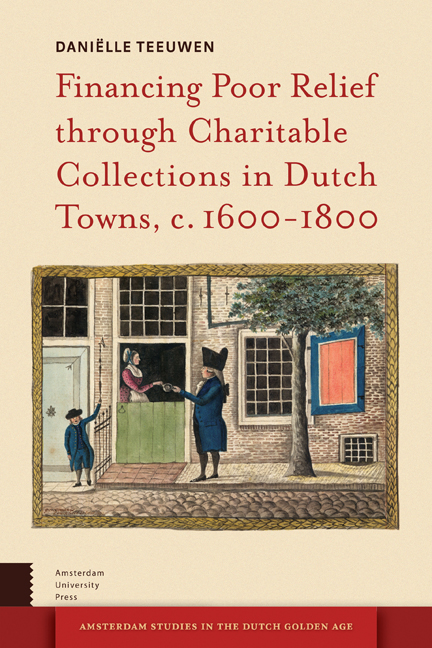2 - Organizing Poor Relief
Published online by Cambridge University Press: 10 December 2020
Summary
In the second half of the seventeenth century, the inhabitants of ‘s-Hertogenbosch were at least three times per week at their homes requested to donate to charitable causes. The Nine Blocks, which were district-based organizations, went door-to-door weekly, and collectors for a relief institution supporting poor people detained in the gatehouse made their rounds through town even twice per week. On a less regular basis the Civic Orphanage held public collections in the streets as well, and in the late eighteenth century its Catholic counterpart was allowed to visit the homes of church members to ask for financial contributions. Thus, a variety of relief institutions existed, with different tasks, privileges and responsibilities. This implies that before fully focusing on the phenomenon of charitable collections, it is important that we first examine the way in which poor relief was organized. This will enable a better understanding of, for example, which types of charitable institutions existed, to what extent religious minorities were taken care of or had to organize their own relief, and what role town governments played in providing social care. Due to the decentralized political system and the high level of urban autonomy, large differences existed in this respect. In the Dutch Republic, poor relief was organized at a local level, and a variety of arrangements were in place in the different cities, towns and villages. At times almoners appointed by urban authorities were in full control, while in other localities secular and religious poor relief administrators worked side by side or the churches took responsibility to care for the poor outside of their own communities. This chapter explains the poor relief arrangements that existed in Delft, Zwolle, Utrecht and ‘s-Hertogenbosch, to provide an insight into the multiform ways in which social care was organized.
Reforming medieval social care
The Middle Ages had already seen the establishment of a multitude of institutions providing relief for those in need. Churches and monasteries initially took the lead in organizing social care. According to canon law, parishes were obliged to assist the poor, and priests had to spend a part of the parish income on charitable distributions. Christian duties included feeding the hungry, giving drink to the thirsty, clothing the naked, sheltering the homeless, comforting the sick, visiting the imprisoned and burying the dead.
- Type
- Chapter
- Information
- Publisher: Amsterdam University PressPrint publication year: 2015



